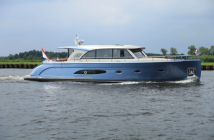Sooner or later, everybody gets seasick. If not actually sick, then certainly queasy. One of my best friends has been cruising on sail and powerboats for almost 50 years. Hardly a novice, he’s won the Bermuda Race and a Transatlantic, among other things. And he still gets seasick every time he start a voyage. “I just figure I’m going to be miserable for about two days and then everything will be OK,” he says.
Over the years, I think I’ve tried just about everything, wrist bands, ear patches, whatever, for various members of my family to keep them from getting seasick. The only thing that seems to work consistently is ginger snaps or ginger ale, particularly with children. I’m generally OK, except when I get diesel fumes coming over the transom in a following sea during a fishing tournament; that’s definitely not good.
The mere prospect of getting seasick can definitely put a damper on the start of a cruise, and it often keeps people from embarking to begin with. It can be the worst feeling in the world, and nobody wants to experience it, or to be with someone who is truly miserable and just wants to curl up and die – or preferably return to dry land.
Here’s some advice from NOAA, about what causes seasickness, and what you can do about it:
One of the least pleasant aspects of going to sea is the possibility of getting seasick. An individual’s susceptibility to seasickness is highly variable. If you’ve ever had motion sickness when traveling by car, plane, or amusement park ride, you may be more susceptible to seasickness while aboard a vessel.
Seasickness is a result of a conflict in the inner ear, where the human balance mechanism resides, and is caused by a vessel’s erratic motion on the water. Inside the cabin of a rocking boat, for example, the inner ear detects changes in both up-and-down and side-to-side acceleration as one’s body bobs along with the boat. But, since the cabin moves with the passenger, one’s eyes register a relatively stable scene. Agitated by this perceptual incongruity, the brain responds with a cascade of stress-related hormones that can ultimately lead to nausea, vomiting, and vertigo.
Additionally, an affected person’s symptoms can be magnified by the strong odors of things like diesel fumes and fish. Seasickness usually occurs in the first 12 to 24 hours after “setting sail,” and dissipates once the body acclimates to the ship’s motion. It’s rare for anyone to get or stay ill beyond the first couple of days at sea – unless the vessel encounters really rough waves. Read more:




